Civil Engineering Technology Report: Earthwork, Hazards, and Design
VerifiedAdded on 2023/01/23
|18
|3317
|42
Report
AI Summary
This report provides a comprehensive overview of civil engineering technology, addressing various aspects of construction and design. It begins with an analysis of earthwork, including excavation, transportation, and compaction techniques, along with the equipment used. The report then explores methods for creating complex foundations, piling works, and drainage systems. It also covers the construction of culverts and underpasses, as well as techniques for managing large-scale earthmoving operations and deep excavations. Furthermore, the report delves into the hazards and risks associated with working in confined spaces and on tall structures, including a method statement for site installation and a sample risk assessment plan. The report also examines health and safety legislation relevant to civil engineering sites. The environmental, quality, geotechnical, and economic contexts of a civil engineering problem are discussed, along with methods and techniques used in highway design, considering design standards and guidelines. The report provides a detailed analysis of the topic with a focus on practical application and theoretical understanding.
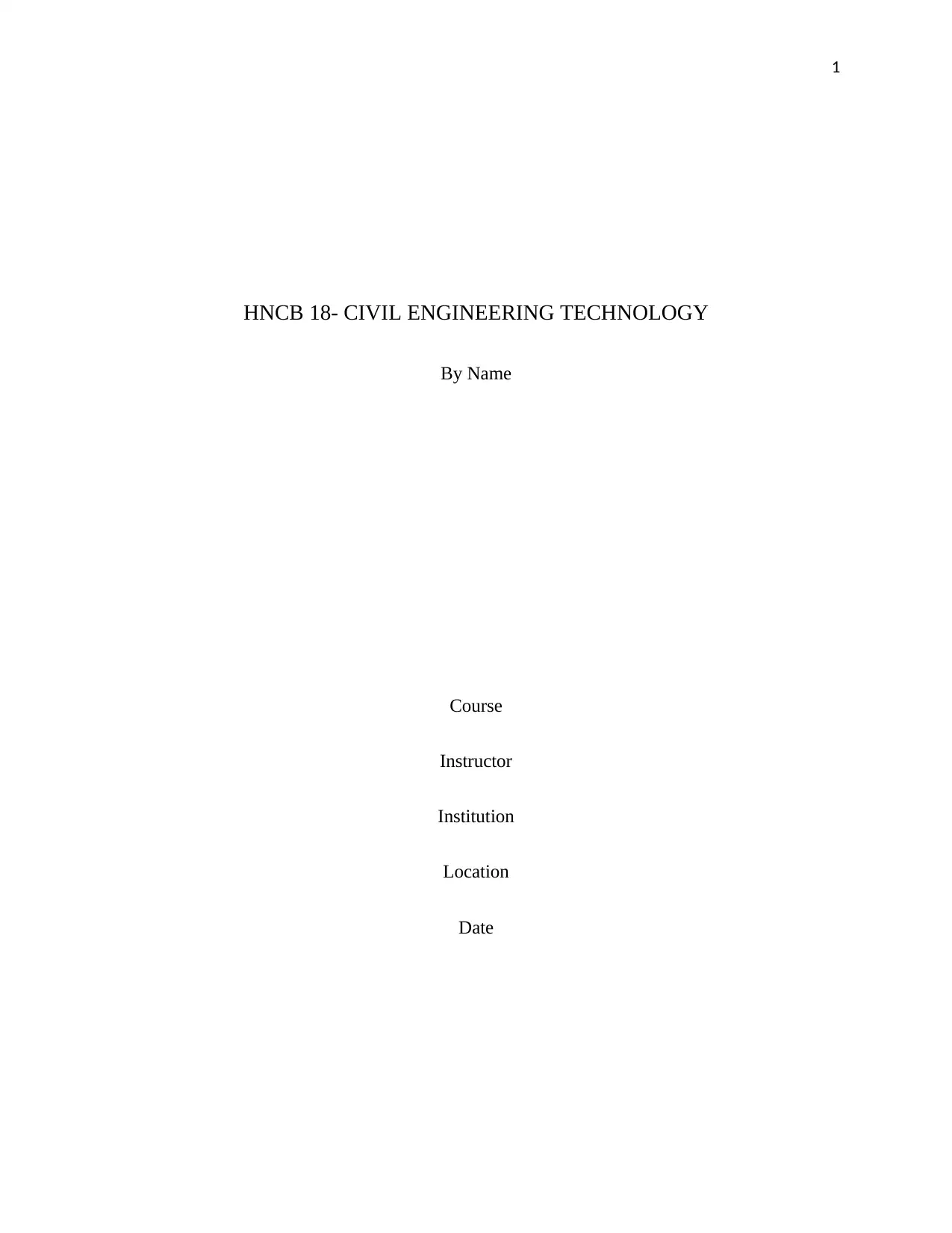
1
HNCB 18- CIVIL ENGINEERING TECHNOLOGY
By Name
Course
Instructor
Institution
Location
Date
HNCB 18- CIVIL ENGINEERING TECHNOLOGY
By Name
Course
Instructor
Institution
Location
Date
Paraphrase This Document
Need a fresh take? Get an instant paraphrase of this document with our AI Paraphraser
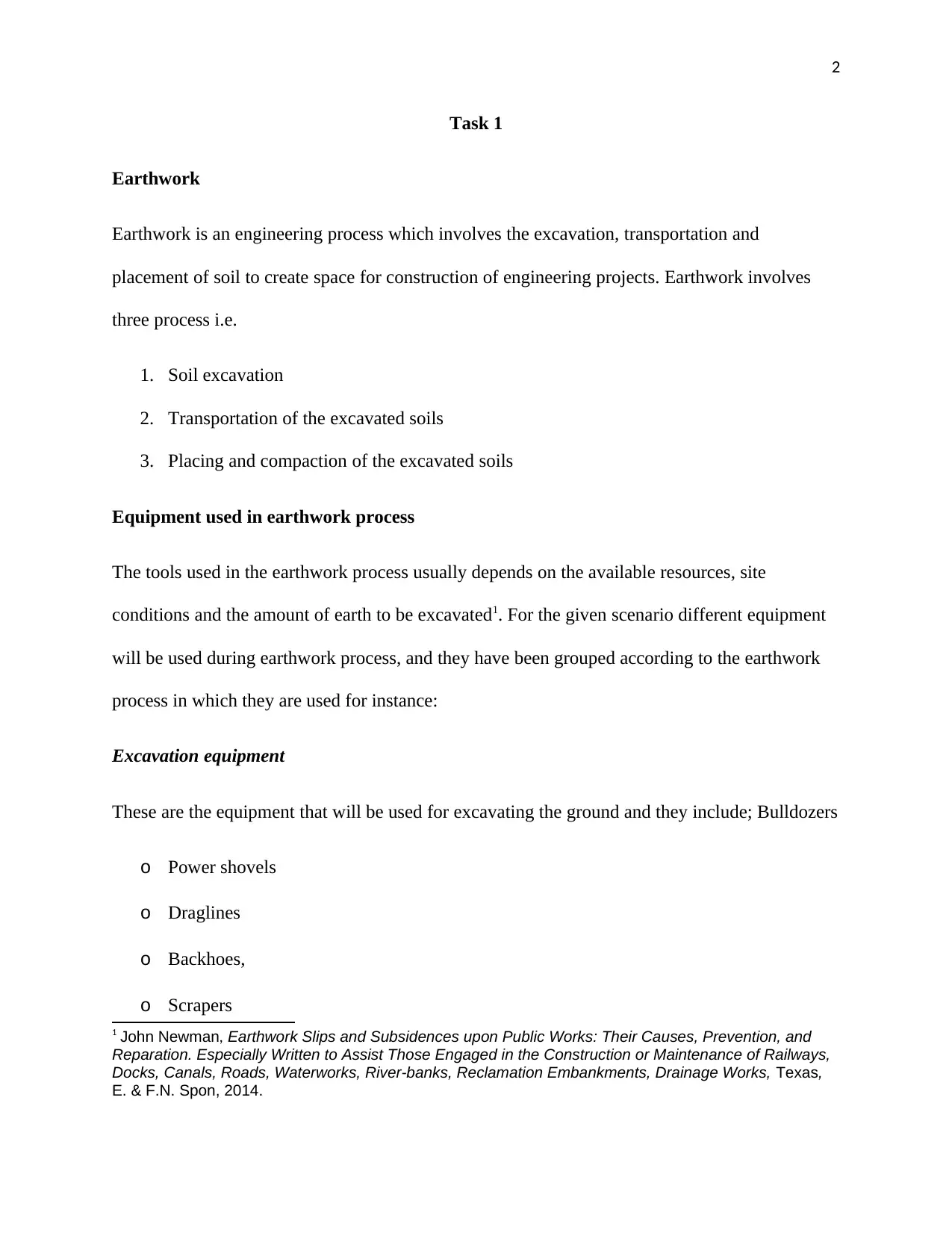
2
Task 1
Earthwork
Earthwork is an engineering process which involves the excavation, transportation and
placement of soil to create space for construction of engineering projects. Earthwork involves
three process i.e.
1. Soil excavation
2. Transportation of the excavated soils
3. Placing and compaction of the excavated soils
Equipment used in earthwork process
The tools used in the earthwork process usually depends on the available resources, site
conditions and the amount of earth to be excavated1. For the given scenario different equipment
will be used during earthwork process, and they have been grouped according to the earthwork
process in which they are used for instance:
Excavation equipment
These are the equipment that will be used for excavating the ground and they include; Bulldozers
o Power shovels
o Draglines
o Backhoes,
o Scrapers
1 John Newman, Earthwork Slips and Subsidences upon Public Works: Their Causes, Prevention, and
Reparation. Especially Written to Assist Those Engaged in the Construction or Maintenance of Railways,
Docks, Canals, Roads, Waterworks, River-banks, Reclamation Embankments, Drainage Works, Texas,
E. & F.N. Spon, 2014.
Task 1
Earthwork
Earthwork is an engineering process which involves the excavation, transportation and
placement of soil to create space for construction of engineering projects. Earthwork involves
three process i.e.
1. Soil excavation
2. Transportation of the excavated soils
3. Placing and compaction of the excavated soils
Equipment used in earthwork process
The tools used in the earthwork process usually depends on the available resources, site
conditions and the amount of earth to be excavated1. For the given scenario different equipment
will be used during earthwork process, and they have been grouped according to the earthwork
process in which they are used for instance:
Excavation equipment
These are the equipment that will be used for excavating the ground and they include; Bulldozers
o Power shovels
o Draglines
o Backhoes,
o Scrapers
1 John Newman, Earthwork Slips and Subsidences upon Public Works: Their Causes, Prevention, and
Reparation. Especially Written to Assist Those Engaged in the Construction or Maintenance of Railways,
Docks, Canals, Roads, Waterworks, River-banks, Reclamation Embankments, Drainage Works, Texas,
E. & F.N. Spon, 2014.
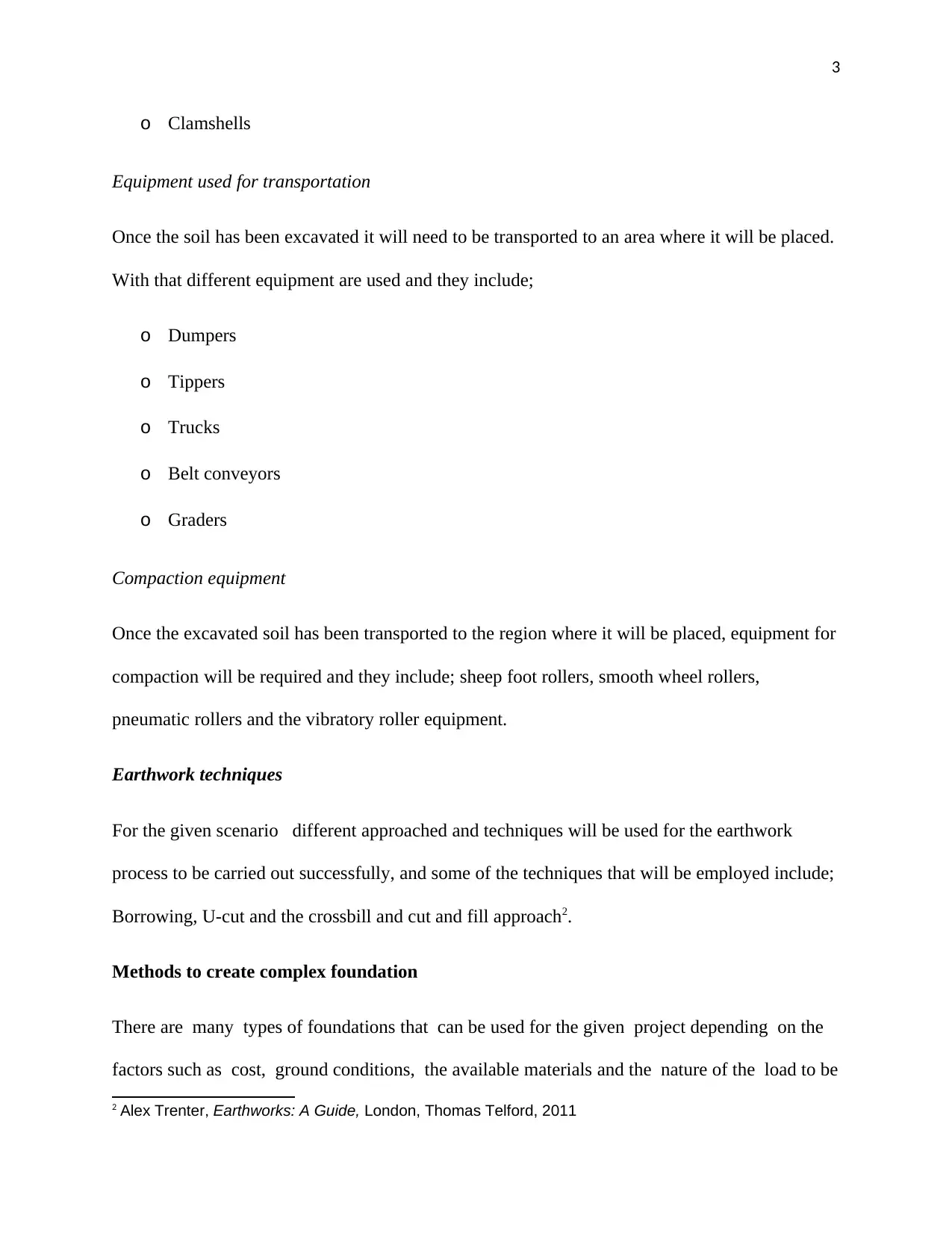
3
o Clamshells
Equipment used for transportation
Once the soil has been excavated it will need to be transported to an area where it will be placed.
With that different equipment are used and they include;
o Dumpers
o Tippers
o Trucks
o Belt conveyors
o Graders
Compaction equipment
Once the excavated soil has been transported to the region where it will be placed, equipment for
compaction will be required and they include; sheep foot rollers, smooth wheel rollers,
pneumatic rollers and the vibratory roller equipment.
Earthwork techniques
For the given scenario different approached and techniques will be used for the earthwork
process to be carried out successfully, and some of the techniques that will be employed include;
Borrowing, U-cut and the crossbill and cut and fill approach2.
Methods to create complex foundation
There are many types of foundations that can be used for the given project depending on the
factors such as cost, ground conditions, the available materials and the nature of the load to be
2 Alex Trenter, Earthworks: A Guide, London, Thomas Telford, 2011
o Clamshells
Equipment used for transportation
Once the soil has been excavated it will need to be transported to an area where it will be placed.
With that different equipment are used and they include;
o Dumpers
o Tippers
o Trucks
o Belt conveyors
o Graders
Compaction equipment
Once the excavated soil has been transported to the region where it will be placed, equipment for
compaction will be required and they include; sheep foot rollers, smooth wheel rollers,
pneumatic rollers and the vibratory roller equipment.
Earthwork techniques
For the given scenario different approached and techniques will be used for the earthwork
process to be carried out successfully, and some of the techniques that will be employed include;
Borrowing, U-cut and the crossbill and cut and fill approach2.
Methods to create complex foundation
There are many types of foundations that can be used for the given project depending on the
factors such as cost, ground conditions, the available materials and the nature of the load to be
2 Alex Trenter, Earthworks: A Guide, London, Thomas Telford, 2011
⊘ This is a preview!⊘
Do you want full access?
Subscribe today to unlock all pages.

Trusted by 1+ million students worldwide
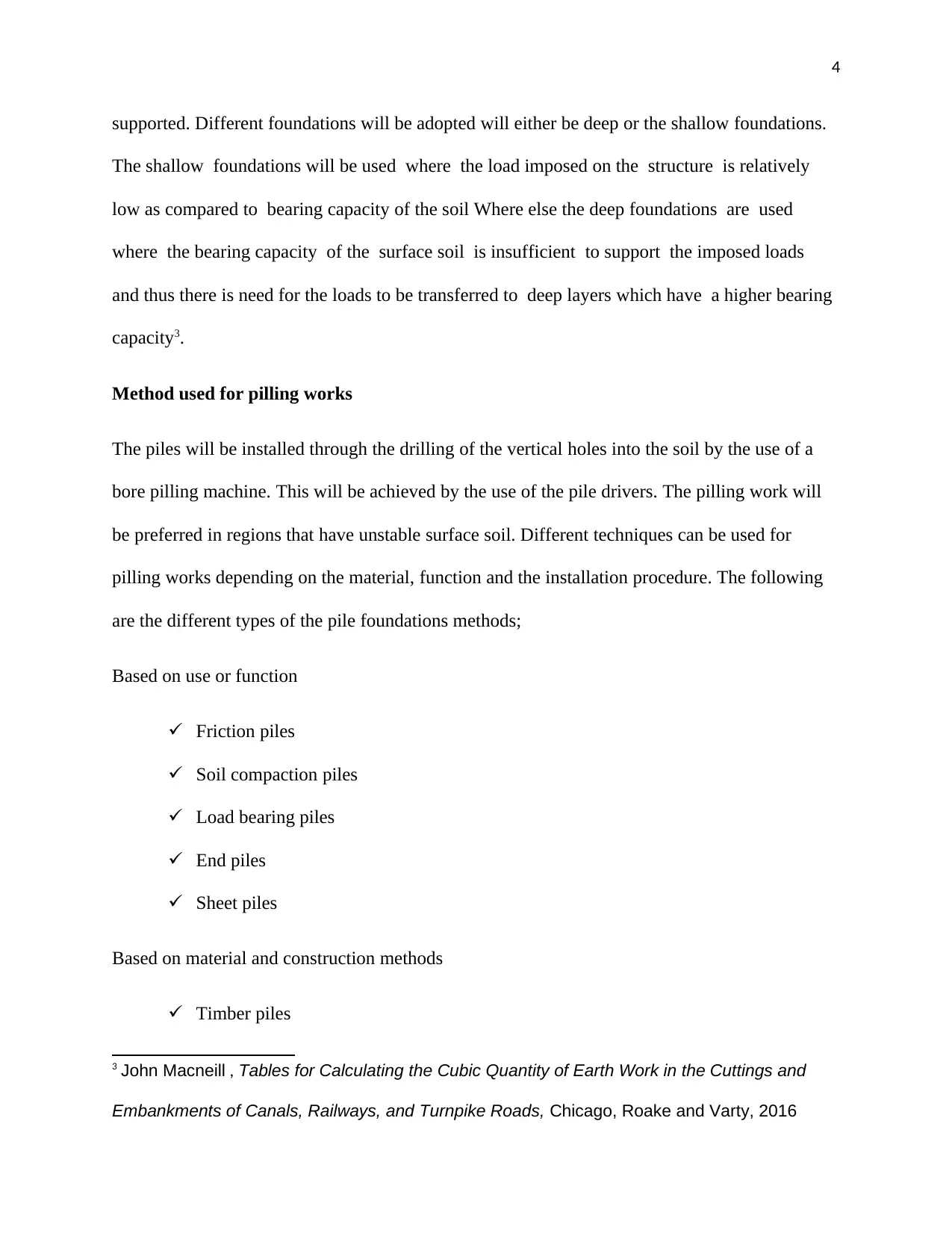
4
supported. Different foundations will be adopted will either be deep or the shallow foundations.
The shallow foundations will be used where the load imposed on the structure is relatively
low as compared to bearing capacity of the soil Where else the deep foundations are used
where the bearing capacity of the surface soil is insufficient to support the imposed loads
and thus there is need for the loads to be transferred to deep layers which have a higher bearing
capacity3.
Method used for pilling works
The piles will be installed through the drilling of the vertical holes into the soil by the use of a
bore pilling machine. This will be achieved by the use of the pile drivers. The pilling work will
be preferred in regions that have unstable surface soil. Different techniques can be used for
pilling works depending on the material, function and the installation procedure. The following
are the different types of the pile foundations methods;
Based on use or function
Friction piles
Soil compaction piles
Load bearing piles
End piles
Sheet piles
Based on material and construction methods
Timber piles
3 John Macneill , Tables for Calculating the Cubic Quantity of Earth Work in the Cuttings and
Embankments of Canals, Railways, and Turnpike Roads, Chicago, Roake and Varty, 2016
supported. Different foundations will be adopted will either be deep or the shallow foundations.
The shallow foundations will be used where the load imposed on the structure is relatively
low as compared to bearing capacity of the soil Where else the deep foundations are used
where the bearing capacity of the surface soil is insufficient to support the imposed loads
and thus there is need for the loads to be transferred to deep layers which have a higher bearing
capacity3.
Method used for pilling works
The piles will be installed through the drilling of the vertical holes into the soil by the use of a
bore pilling machine. This will be achieved by the use of the pile drivers. The pilling work will
be preferred in regions that have unstable surface soil. Different techniques can be used for
pilling works depending on the material, function and the installation procedure. The following
are the different types of the pile foundations methods;
Based on use or function
Friction piles
Soil compaction piles
Load bearing piles
End piles
Sheet piles
Based on material and construction methods
Timber piles
3 John Macneill , Tables for Calculating the Cubic Quantity of Earth Work in the Cuttings and
Embankments of Canals, Railways, and Turnpike Roads, Chicago, Roake and Varty, 2016
Paraphrase This Document
Need a fresh take? Get an instant paraphrase of this document with our AI Paraphraser
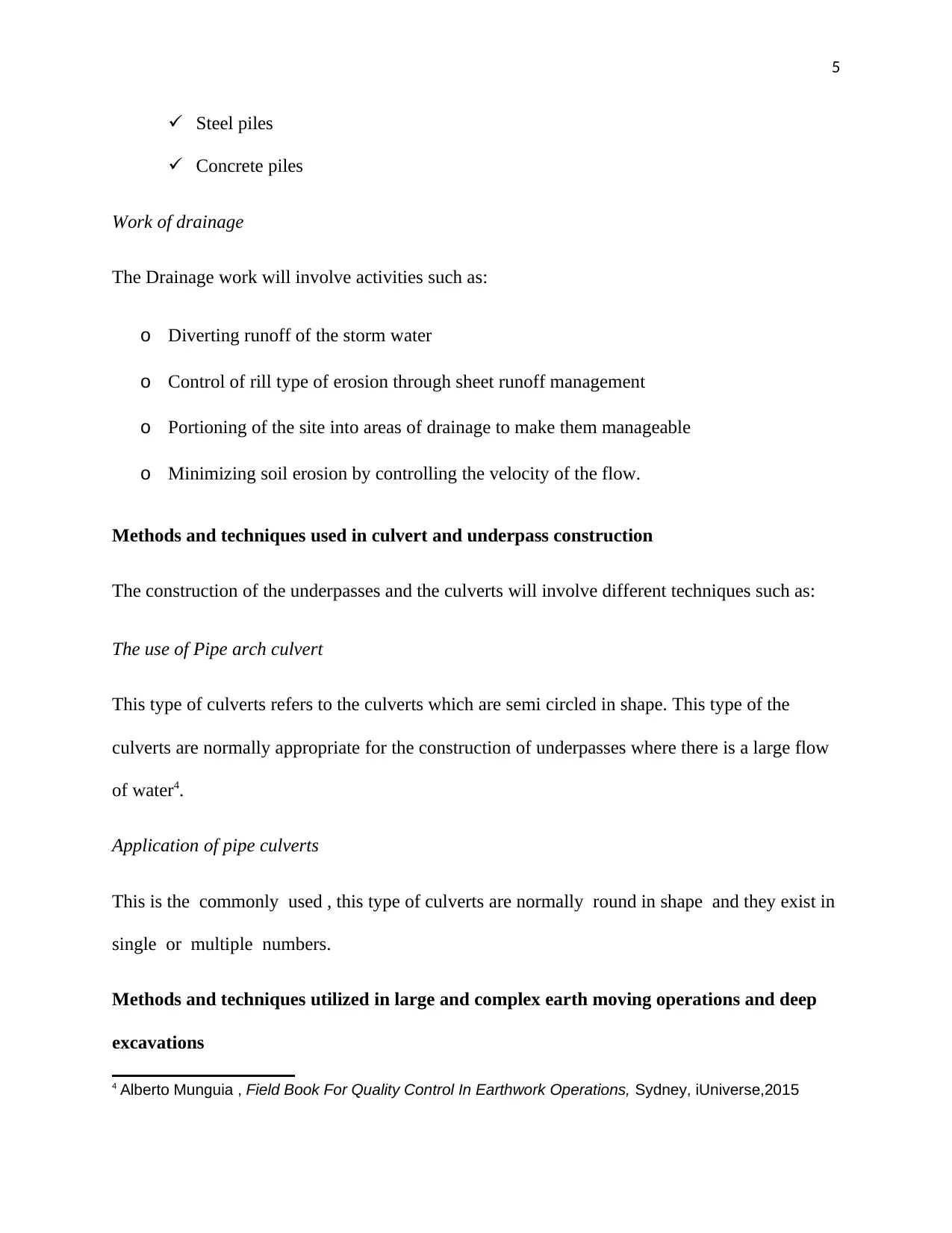
5
Steel piles
Concrete piles
Work of drainage
The Drainage work will involve activities such as:
o Diverting runoff of the storm water
o Control of rill type of erosion through sheet runoff management
o Portioning of the site into areas of drainage to make them manageable
o Minimizing soil erosion by controlling the velocity of the flow.
Methods and techniques used in culvert and underpass construction
The construction of the underpasses and the culverts will involve different techniques such as:
The use of Pipe arch culvert
This type of culverts refers to the culverts which are semi circled in shape. This type of the
culverts are normally appropriate for the construction of underpasses where there is a large flow
of water4.
Application of pipe culverts
This is the commonly used , this type of culverts are normally round in shape and they exist in
single or multiple numbers.
Methods and techniques utilized in large and complex earth moving operations and deep
excavations
4 Alberto Munguia , Field Book For Quality Control In Earthwork Operations, Sydney, iUniverse,2015
Steel piles
Concrete piles
Work of drainage
The Drainage work will involve activities such as:
o Diverting runoff of the storm water
o Control of rill type of erosion through sheet runoff management
o Portioning of the site into areas of drainage to make them manageable
o Minimizing soil erosion by controlling the velocity of the flow.
Methods and techniques used in culvert and underpass construction
The construction of the underpasses and the culverts will involve different techniques such as:
The use of Pipe arch culvert
This type of culverts refers to the culverts which are semi circled in shape. This type of the
culverts are normally appropriate for the construction of underpasses where there is a large flow
of water4.
Application of pipe culverts
This is the commonly used , this type of culverts are normally round in shape and they exist in
single or multiple numbers.
Methods and techniques utilized in large and complex earth moving operations and deep
excavations
4 Alberto Munguia , Field Book For Quality Control In Earthwork Operations, Sydney, iUniverse,2015
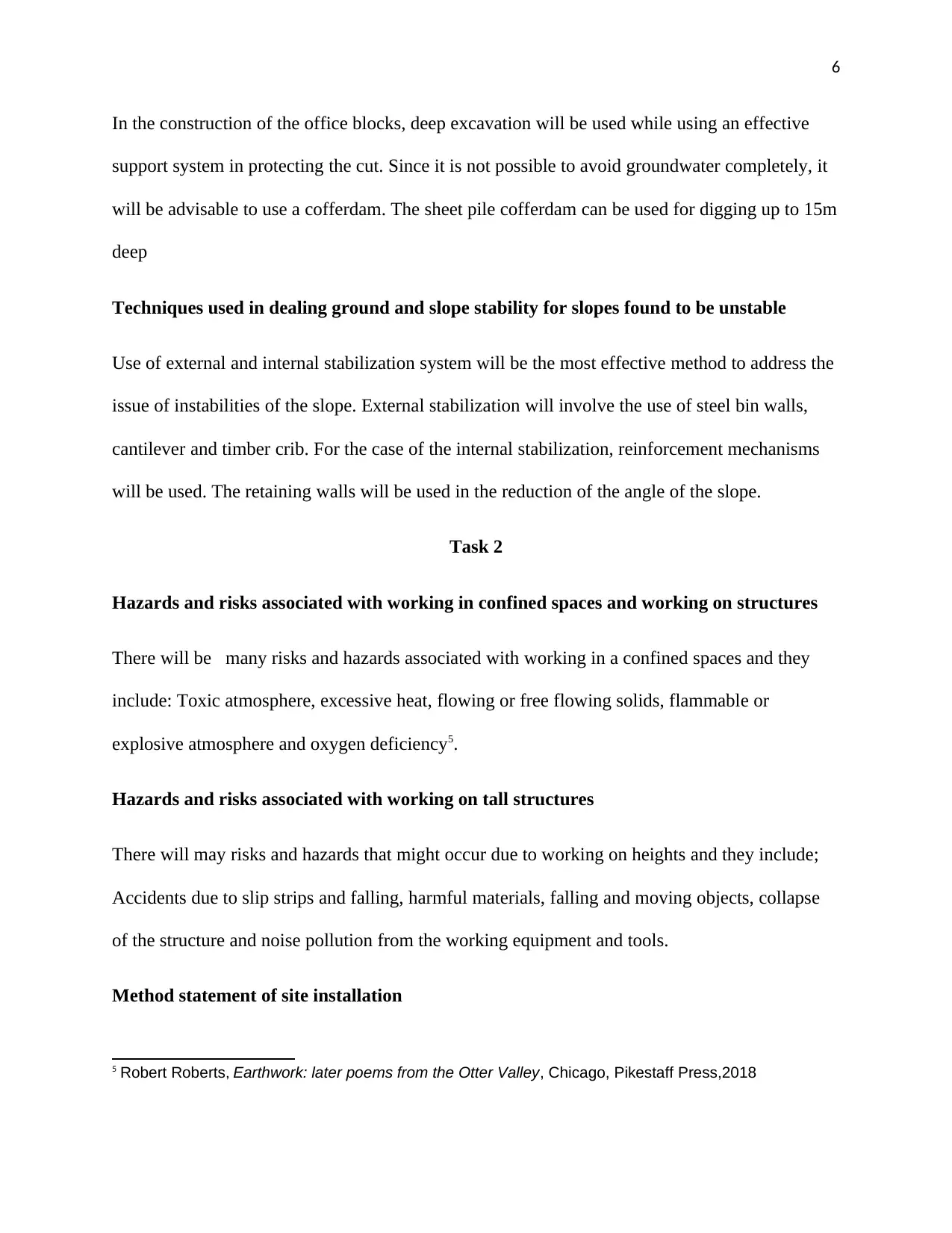
6
In the construction of the office blocks, deep excavation will be used while using an effective
support system in protecting the cut. Since it is not possible to avoid groundwater completely, it
will be advisable to use a cofferdam. The sheet pile cofferdam can be used for digging up to 15m
deep
Techniques used in dealing ground and slope stability for slopes found to be unstable
Use of external and internal stabilization system will be the most effective method to address the
issue of instabilities of the slope. External stabilization will involve the use of steel bin walls,
cantilever and timber crib. For the case of the internal stabilization, reinforcement mechanisms
will be used. The retaining walls will be used in the reduction of the angle of the slope.
Task 2
Hazards and risks associated with working in confined spaces and working on structures
There will be many risks and hazards associated with working in a confined spaces and they
include: Toxic atmosphere, excessive heat, flowing or free flowing solids, flammable or
explosive atmosphere and oxygen deficiency5.
Hazards and risks associated with working on tall structures
There will may risks and hazards that might occur due to working on heights and they include;
Accidents due to slip strips and falling, harmful materials, falling and moving objects, collapse
of the structure and noise pollution from the working equipment and tools.
Method statement of site installation
5 Robert Roberts, Earthwork: later poems from the Otter Valley, Chicago, Pikestaff Press,2018
In the construction of the office blocks, deep excavation will be used while using an effective
support system in protecting the cut. Since it is not possible to avoid groundwater completely, it
will be advisable to use a cofferdam. The sheet pile cofferdam can be used for digging up to 15m
deep
Techniques used in dealing ground and slope stability for slopes found to be unstable
Use of external and internal stabilization system will be the most effective method to address the
issue of instabilities of the slope. External stabilization will involve the use of steel bin walls,
cantilever and timber crib. For the case of the internal stabilization, reinforcement mechanisms
will be used. The retaining walls will be used in the reduction of the angle of the slope.
Task 2
Hazards and risks associated with working in confined spaces and working on structures
There will be many risks and hazards associated with working in a confined spaces and they
include: Toxic atmosphere, excessive heat, flowing or free flowing solids, flammable or
explosive atmosphere and oxygen deficiency5.
Hazards and risks associated with working on tall structures
There will may risks and hazards that might occur due to working on heights and they include;
Accidents due to slip strips and falling, harmful materials, falling and moving objects, collapse
of the structure and noise pollution from the working equipment and tools.
Method statement of site installation
5 Robert Roberts, Earthwork: later poems from the Otter Valley, Chicago, Pikestaff Press,2018
⊘ This is a preview!⊘
Do you want full access?
Subscribe today to unlock all pages.

Trusted by 1+ million students worldwide
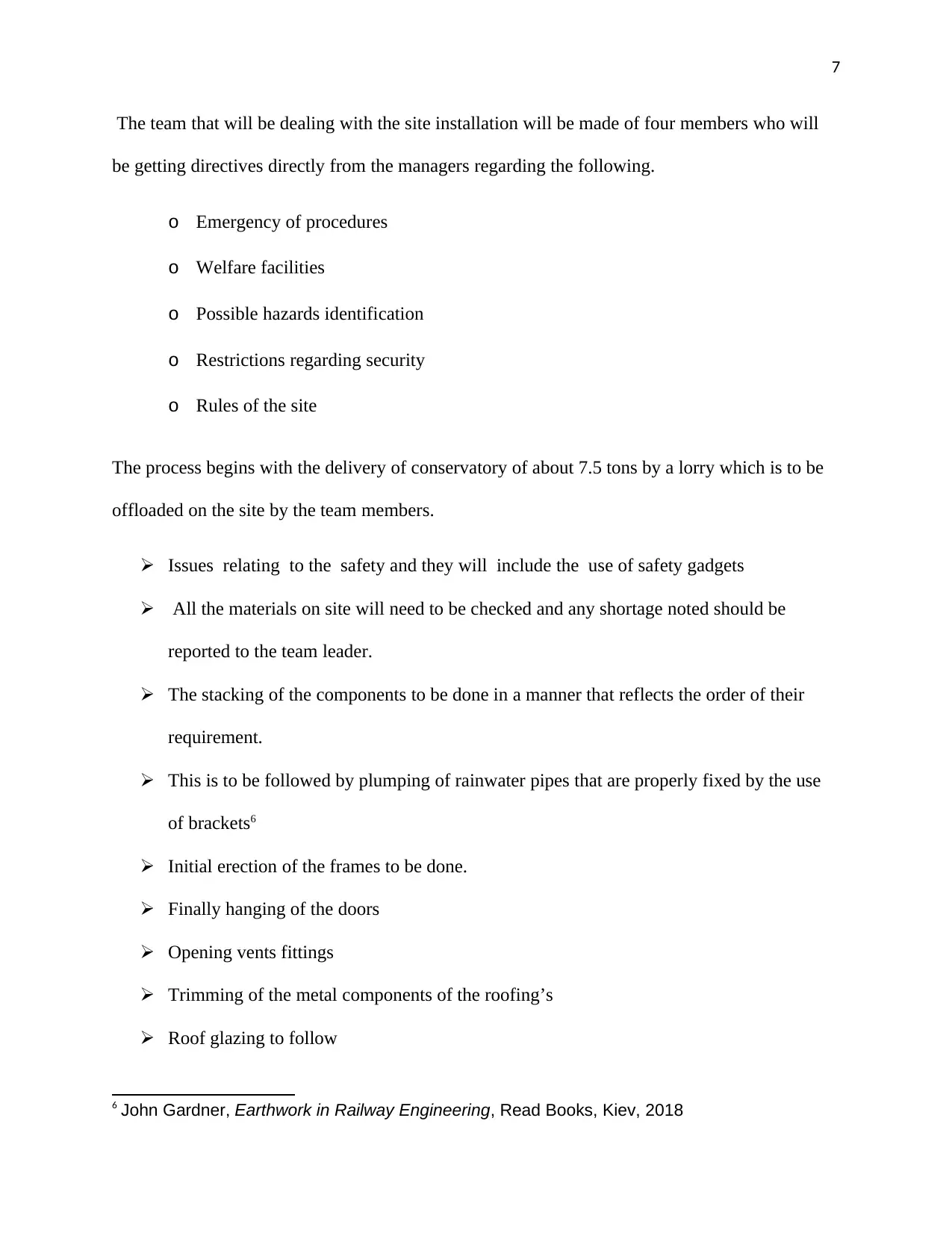
7
The team that will be dealing with the site installation will be made of four members who will
be getting directives directly from the managers regarding the following.
o Emergency of procedures
o Welfare facilities
o Possible hazards identification
o Restrictions regarding security
o Rules of the site
The process begins with the delivery of conservatory of about 7.5 tons by a lorry which is to be
offloaded on the site by the team members.
Issues relating to the safety and they will include the use of safety gadgets
All the materials on site will need to be checked and any shortage noted should be
reported to the team leader.
The stacking of the components to be done in a manner that reflects the order of their
requirement.
This is to be followed by plumping of rainwater pipes that are properly fixed by the use
of brackets6
Initial erection of the frames to be done.
Finally hanging of the doors
Opening vents fittings
Trimming of the metal components of the roofing’s
Roof glazing to follow
6 John Gardner, Earthwork in Railway Engineering, Read Books, Kiev, 2018
The team that will be dealing with the site installation will be made of four members who will
be getting directives directly from the managers regarding the following.
o Emergency of procedures
o Welfare facilities
o Possible hazards identification
o Restrictions regarding security
o Rules of the site
The process begins with the delivery of conservatory of about 7.5 tons by a lorry which is to be
offloaded on the site by the team members.
Issues relating to the safety and they will include the use of safety gadgets
All the materials on site will need to be checked and any shortage noted should be
reported to the team leader.
The stacking of the components to be done in a manner that reflects the order of their
requirement.
This is to be followed by plumping of rainwater pipes that are properly fixed by the use
of brackets6
Initial erection of the frames to be done.
Finally hanging of the doors
Opening vents fittings
Trimming of the metal components of the roofing’s
Roof glazing to follow
6 John Gardner, Earthwork in Railway Engineering, Read Books, Kiev, 2018
Paraphrase This Document
Need a fresh take? Get an instant paraphrase of this document with our AI Paraphraser
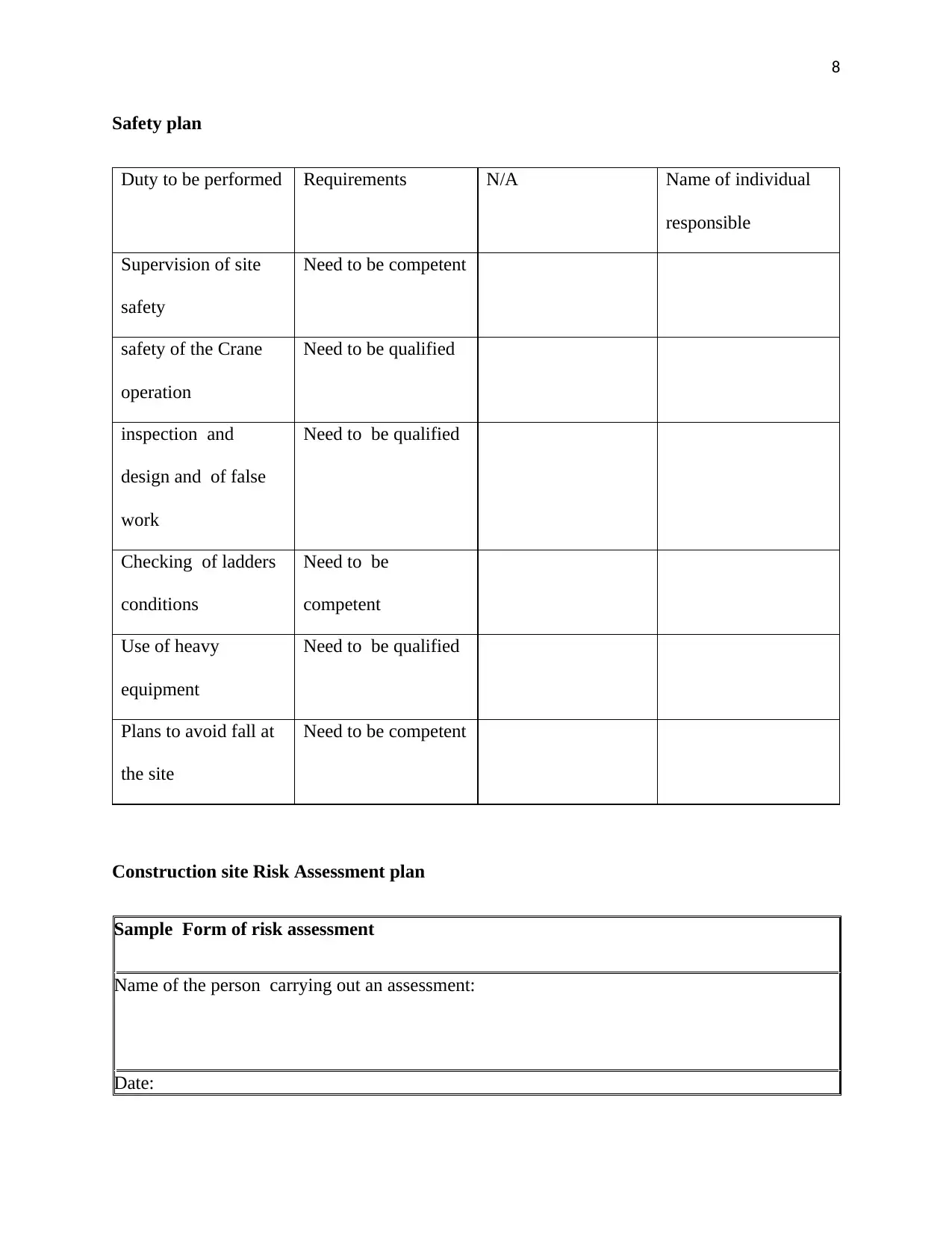
8
Safety plan
Duty to be performed Requirements N/A Name of individual
responsible
Supervision of site
safety
Need to be competent
safety of the Crane
operation
Need to be qualified
inspection and
design and of false
work
Need to be qualified
Checking of ladders
conditions
Need to be
competent
Use of heavy
equipment
Need to be qualified
Plans to avoid fall at
the site
Need to be competent
Construction site Risk Assessment plan
Sample Form of risk assessment
Name of the person carrying out an assessment:
Date:
Safety plan
Duty to be performed Requirements N/A Name of individual
responsible
Supervision of site
safety
Need to be competent
safety of the Crane
operation
Need to be qualified
inspection and
design and of false
work
Need to be qualified
Checking of ladders
conditions
Need to be
competent
Use of heavy
equipment
Need to be qualified
Plans to avoid fall at
the site
Need to be competent
Construction site Risk Assessment plan
Sample Form of risk assessment
Name of the person carrying out an assessment:
Date:
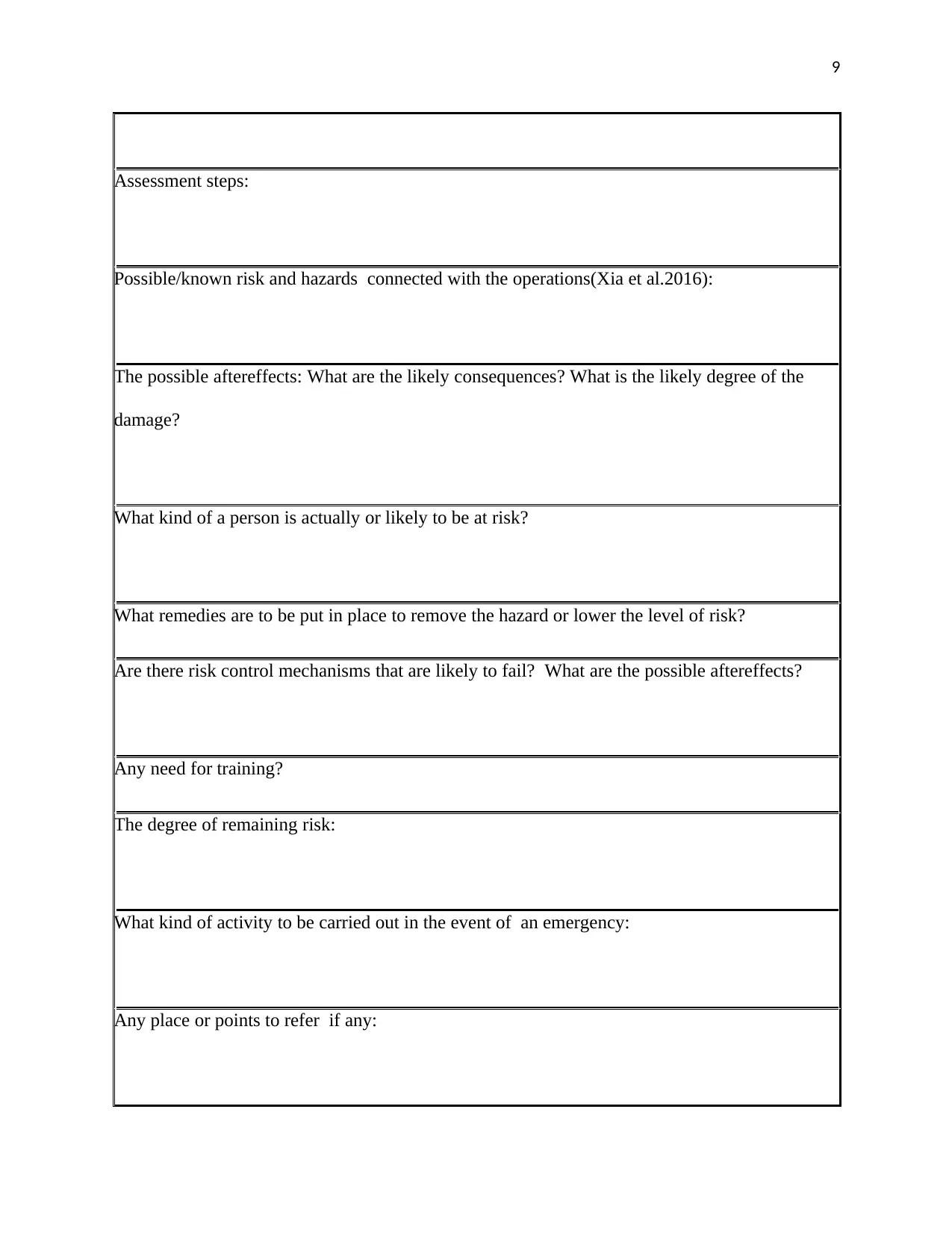
9
Assessment steps:
Possible/known risk and hazards connected with the operations(Xia et al.2016):
The possible aftereffects: What are the likely consequences? What is the likely degree of the
damage?
What kind of a person is actually or likely to be at risk?
What remedies are to be put in place to remove the hazard or lower the level of risk?
Are there risk control mechanisms that are likely to fail? What are the possible aftereffects?
Any need for training?
The degree of remaining risk:
What kind of activity to be carried out in the event of an emergency:
Any place or points to refer if any:
Assessment steps:
Possible/known risk and hazards connected with the operations(Xia et al.2016):
The possible aftereffects: What are the likely consequences? What is the likely degree of the
damage?
What kind of a person is actually or likely to be at risk?
What remedies are to be put in place to remove the hazard or lower the level of risk?
Are there risk control mechanisms that are likely to fail? What are the possible aftereffects?
Any need for training?
The degree of remaining risk:
What kind of activity to be carried out in the event of an emergency:
Any place or points to refer if any:
⊘ This is a preview!⊘
Do you want full access?
Subscribe today to unlock all pages.

Trusted by 1+ million students worldwide
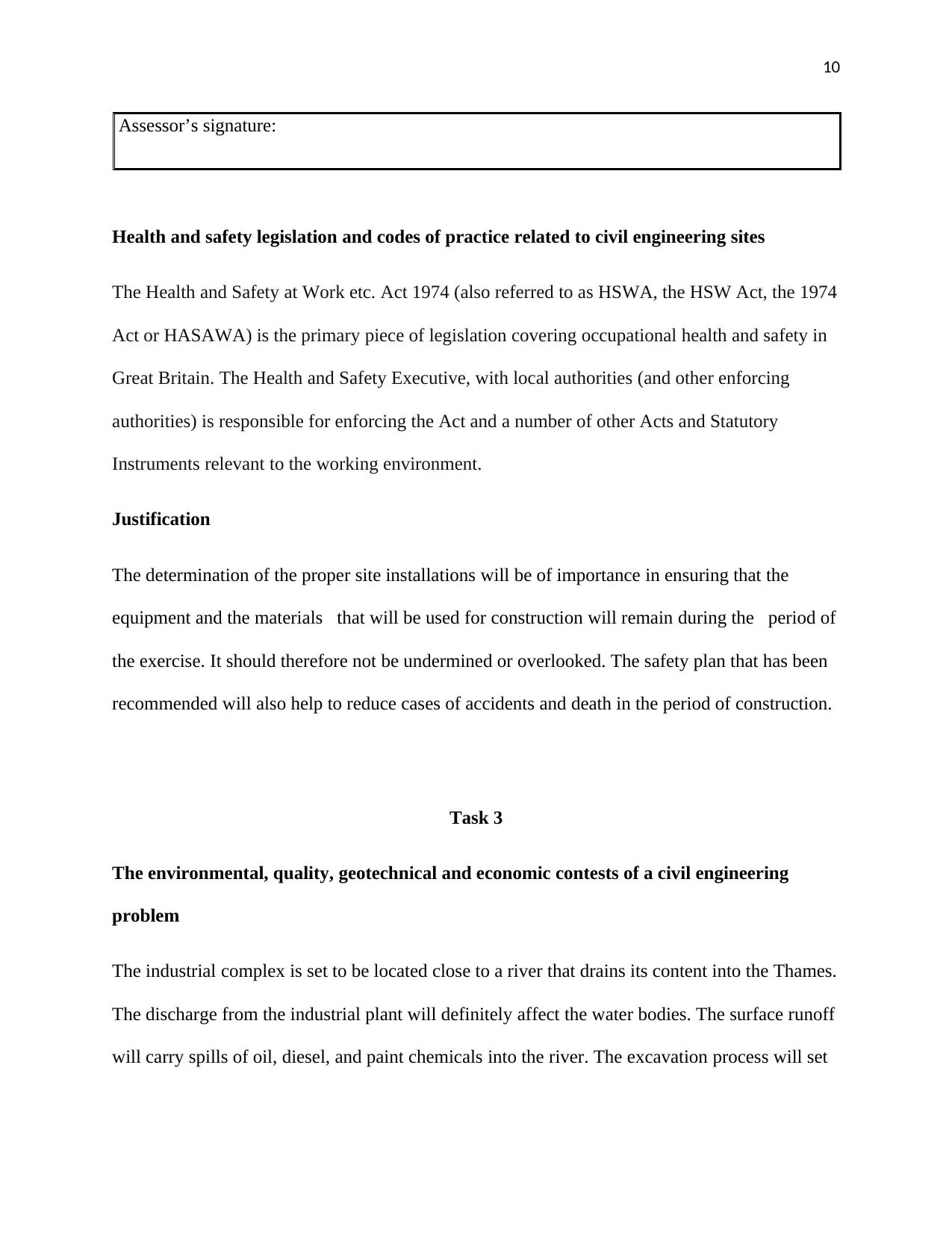
10
Assessor’s signature:
Health and safety legislation and codes of practice related to civil engineering sites
The Health and Safety at Work etc. Act 1974 (also referred to as HSWA, the HSW Act, the 1974
Act or HASAWA) is the primary piece of legislation covering occupational health and safety in
Great Britain. The Health and Safety Executive, with local authorities (and other enforcing
authorities) is responsible for enforcing the Act and a number of other Acts and Statutory
Instruments relevant to the working environment.
Justification
The determination of the proper site installations will be of importance in ensuring that the
equipment and the materials that will be used for construction will remain during the period of
the exercise. It should therefore not be undermined or overlooked. The safety plan that has been
recommended will also help to reduce cases of accidents and death in the period of construction.
Task 3
The environmental, quality, geotechnical and economic contests of a civil engineering
problem
The industrial complex is set to be located close to a river that drains its content into the Thames.
The discharge from the industrial plant will definitely affect the water bodies. The surface runoff
will carry spills of oil, diesel, and paint chemicals into the river. The excavation process will set
Assessor’s signature:
Health and safety legislation and codes of practice related to civil engineering sites
The Health and Safety at Work etc. Act 1974 (also referred to as HSWA, the HSW Act, the 1974
Act or HASAWA) is the primary piece of legislation covering occupational health and safety in
Great Britain. The Health and Safety Executive, with local authorities (and other enforcing
authorities) is responsible for enforcing the Act and a number of other Acts and Statutory
Instruments relevant to the working environment.
Justification
The determination of the proper site installations will be of importance in ensuring that the
equipment and the materials that will be used for construction will remain during the period of
the exercise. It should therefore not be undermined or overlooked. The safety plan that has been
recommended will also help to reduce cases of accidents and death in the period of construction.
Task 3
The environmental, quality, geotechnical and economic contests of a civil engineering
problem
The industrial complex is set to be located close to a river that drains its content into the Thames.
The discharge from the industrial plant will definitely affect the water bodies. The surface runoff
will carry spills of oil, diesel, and paint chemicals into the river. The excavation process will set
Paraphrase This Document
Need a fresh take? Get an instant paraphrase of this document with our AI Paraphraser
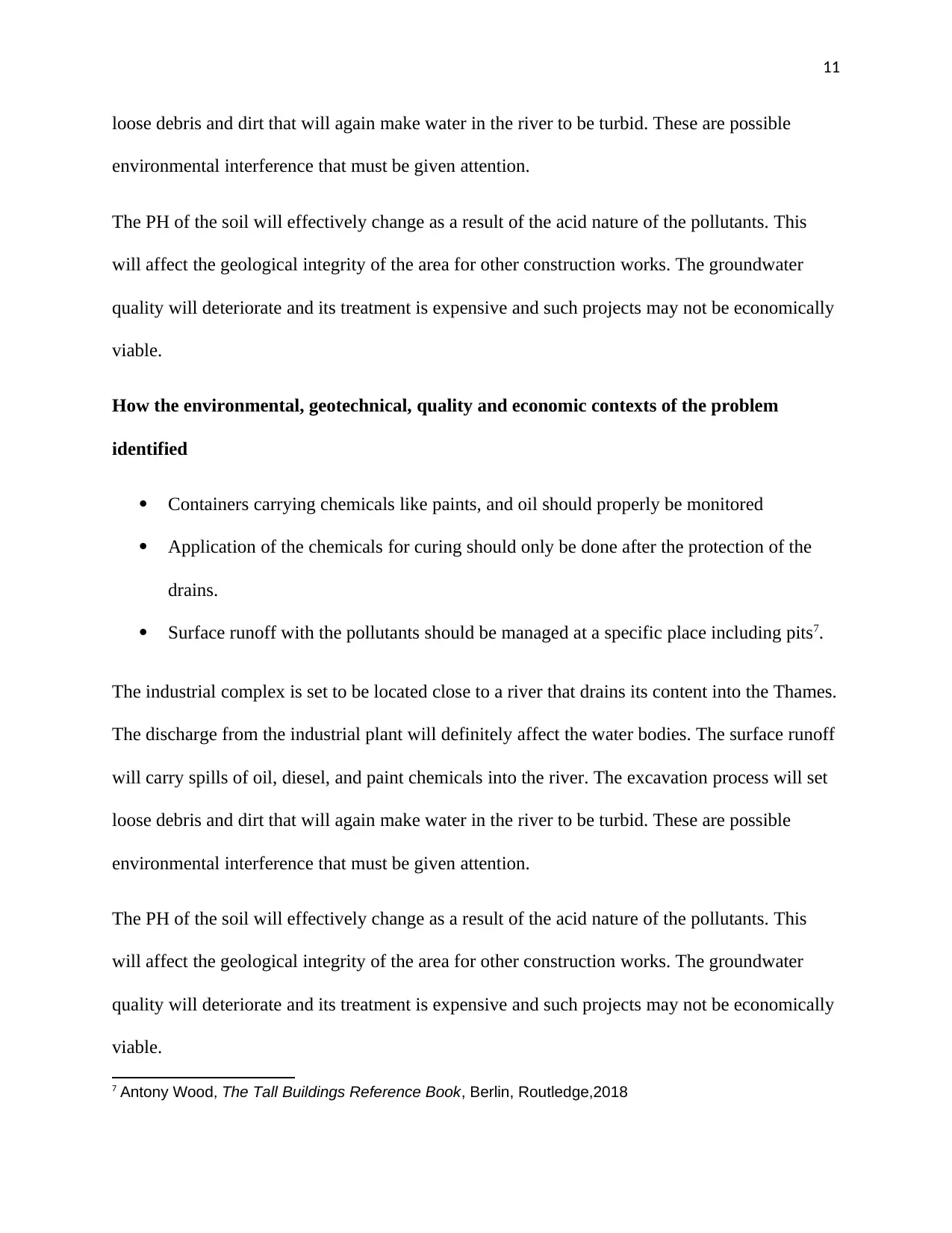
11
loose debris and dirt that will again make water in the river to be turbid. These are possible
environmental interference that must be given attention.
The PH of the soil will effectively change as a result of the acid nature of the pollutants. This
will affect the geological integrity of the area for other construction works. The groundwater
quality will deteriorate and its treatment is expensive and such projects may not be economically
viable.
How the environmental, geotechnical, quality and economic contexts of the problem
identified
Containers carrying chemicals like paints, and oil should properly be monitored
Application of the chemicals for curing should only be done after the protection of the
drains.
Surface runoff with the pollutants should be managed at a specific place including pits7.
The industrial complex is set to be located close to a river that drains its content into the Thames.
The discharge from the industrial plant will definitely affect the water bodies. The surface runoff
will carry spills of oil, diesel, and paint chemicals into the river. The excavation process will set
loose debris and dirt that will again make water in the river to be turbid. These are possible
environmental interference that must be given attention.
The PH of the soil will effectively change as a result of the acid nature of the pollutants. This
will affect the geological integrity of the area for other construction works. The groundwater
quality will deteriorate and its treatment is expensive and such projects may not be economically
viable.
7 Antony Wood, The Tall Buildings Reference Book, Berlin, Routledge,2018
loose debris and dirt that will again make water in the river to be turbid. These are possible
environmental interference that must be given attention.
The PH of the soil will effectively change as a result of the acid nature of the pollutants. This
will affect the geological integrity of the area for other construction works. The groundwater
quality will deteriorate and its treatment is expensive and such projects may not be economically
viable.
How the environmental, geotechnical, quality and economic contexts of the problem
identified
Containers carrying chemicals like paints, and oil should properly be monitored
Application of the chemicals for curing should only be done after the protection of the
drains.
Surface runoff with the pollutants should be managed at a specific place including pits7.
The industrial complex is set to be located close to a river that drains its content into the Thames.
The discharge from the industrial plant will definitely affect the water bodies. The surface runoff
will carry spills of oil, diesel, and paint chemicals into the river. The excavation process will set
loose debris and dirt that will again make water in the river to be turbid. These are possible
environmental interference that must be given attention.
The PH of the soil will effectively change as a result of the acid nature of the pollutants. This
will affect the geological integrity of the area for other construction works. The groundwater
quality will deteriorate and its treatment is expensive and such projects may not be economically
viable.
7 Antony Wood, The Tall Buildings Reference Book, Berlin, Routledge,2018
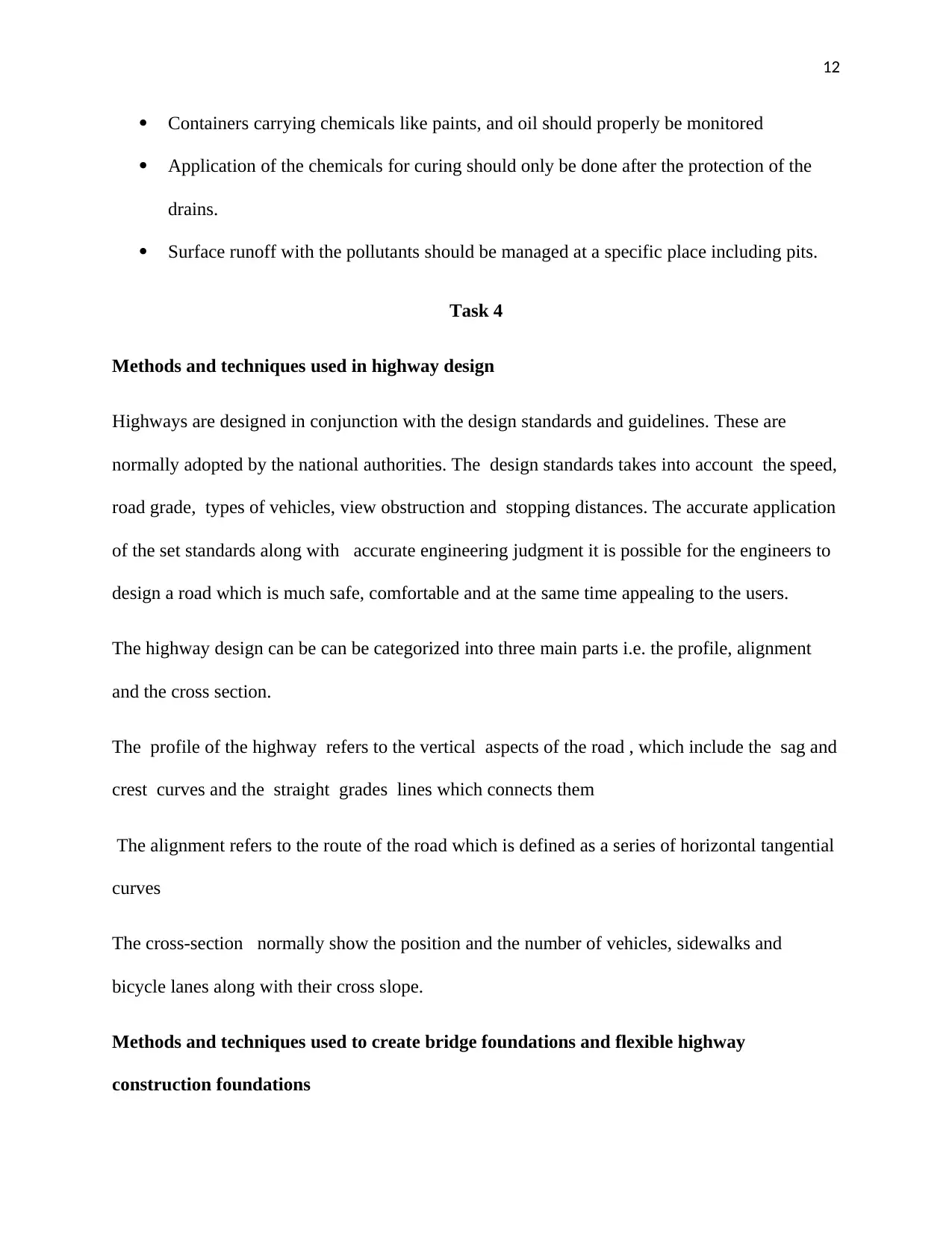
12
Containers carrying chemicals like paints, and oil should properly be monitored
Application of the chemicals for curing should only be done after the protection of the
drains.
Surface runoff with the pollutants should be managed at a specific place including pits.
Task 4
Methods and techniques used in highway design
Highways are designed in conjunction with the design standards and guidelines. These are
normally adopted by the national authorities. The design standards takes into account the speed,
road grade, types of vehicles, view obstruction and stopping distances. The accurate application
of the set standards along with accurate engineering judgment it is possible for the engineers to
design a road which is much safe, comfortable and at the same time appealing to the users.
The highway design can be can be categorized into three main parts i.e. the profile, alignment
and the cross section.
The profile of the highway refers to the vertical aspects of the road , which include the sag and
crest curves and the straight grades lines which connects them
The alignment refers to the route of the road which is defined as a series of horizontal tangential
curves
The cross-section normally show the position and the number of vehicles, sidewalks and
bicycle lanes along with their cross slope.
Methods and techniques used to create bridge foundations and flexible highway
construction foundations
Containers carrying chemicals like paints, and oil should properly be monitored
Application of the chemicals for curing should only be done after the protection of the
drains.
Surface runoff with the pollutants should be managed at a specific place including pits.
Task 4
Methods and techniques used in highway design
Highways are designed in conjunction with the design standards and guidelines. These are
normally adopted by the national authorities. The design standards takes into account the speed,
road grade, types of vehicles, view obstruction and stopping distances. The accurate application
of the set standards along with accurate engineering judgment it is possible for the engineers to
design a road which is much safe, comfortable and at the same time appealing to the users.
The highway design can be can be categorized into three main parts i.e. the profile, alignment
and the cross section.
The profile of the highway refers to the vertical aspects of the road , which include the sag and
crest curves and the straight grades lines which connects them
The alignment refers to the route of the road which is defined as a series of horizontal tangential
curves
The cross-section normally show the position and the number of vehicles, sidewalks and
bicycle lanes along with their cross slope.
Methods and techniques used to create bridge foundations and flexible highway
construction foundations
⊘ This is a preview!⊘
Do you want full access?
Subscribe today to unlock all pages.

Trusted by 1+ million students worldwide
1 out of 18
Related Documents
Your All-in-One AI-Powered Toolkit for Academic Success.
+13062052269
info@desklib.com
Available 24*7 on WhatsApp / Email
![[object Object]](/_next/static/media/star-bottom.7253800d.svg)
Unlock your academic potential
Copyright © 2020–2025 A2Z Services. All Rights Reserved. Developed and managed by ZUCOL.




